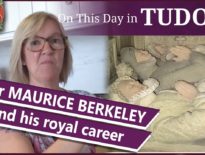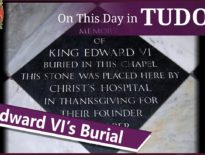On this day in Tudor history, 9th August 1561, while on a visit to Ipswich, in Suffolk, Queen Elizabeth I issued a royal mandate forbidding women to reside in cathedrals and colleges.
Although she wasn't going as far as banning clerical marriage, her mandate caused concern, and even horror, among her clergy, particularly her married Archbishop of Canterbury, who was a huge supporter of clerical marriage.
Find out more about what Elizabeth I ordered, the reactions of William Cecil, Matthew Parker and Richard Cox, and why the Protestant Elizabeth may have issued this mandate, in today's talk.
Also on this day in Tudor history, 9th August 1588, Queen Elizabeth I gave her famous Tilbury Speech to the forces gathered at Tilbury Fort. It is a speech that has been immortalised on screen by the likes of Glenda Jackson and Cate Blanchett, and is famous for the line "I know I have the body but of a weak and feeble woman; but I have the heart and stomach of a king, and of a king of England too", but what words did Elizabeth really speak that day? Find out in last year’s video:
Also on this day in history:
- 1556 – Funeral of Sir William Laxton, Lord Mayor of London (1544-5) and one of the wealthiest London merchants, at the parish church in St Mary Aldermary. The funeral was followed by a banquet hosted by the Grocers' Company of London and a mass led by John Harpsfield, Archdeacon of London.
- 1557 – Burial of the composer Nicholas Ludford in St Margaret's Church, Westminster. Ludford is known for his festal masses, which can be found in the Caius and Lambeth choirbooks (1521-27) and the Peterhouse partbooks (1539-40), and has been described as “"one of the last unsung geniuses of Tudor polyphony" (David Skinner).
- 1611 – Death of John Blagrave, mathematician and land surveyor. He was buried in St Lawrence's Church, Reading. Blagrave's works included “The Mathematical Jewel” (1585), Astrolabium Uranicum generale (1596) and “The Art of Dyalling” (1609). He also designed and made instruments, including sundials and astrolabes.
Transcript:
On this day in Tudor history, 9th August 1561, while on a visit to Ipswich, in Suffolk, Queen Elizabeth I issued a royal mandate forbidding women to reside in cathedrals and colleges, stating:
“that no manner of person, being either the head or member of any college or cathedral church within this realm, shall, from the time of notification hereof in the same college, have, or be permitted to have, within the precinct of any such college, his wife, or other woman, to abide and dwell in the same, or to frequent and haunt any lodging within the same college, upon pain that whoever shall do to the contrary shall forfeit all ecclesiastical promotions in any cathedral or collegiate church within the realm.”
Elizabeth had been shocked by the number of women and children in the cathedrals and churches, and felt that they distracted and tempted the clergy away from their religious studies and prayer. She wasn’t going to go as far as banning clerical marriage, but she didn’t think it was appropriate for clergymen and their wives to be together in cathedral grounds, so she wasn’t encouraging clerical marriage by making things difficult for couples and families.
A concerned William Cecil, Lord Burghley, sent the mandate to Matthew Parker, Archbishop of Canterbury, commenting that “Her Majesty continueth very evil affected to the state of matrimony in the clergy. And if I were not therein very stiff, Her Majesty would utterly and openly condemn and forbid it.” The news must have worried the archbishop, who had been married since 1547, and he replied, saying that he “was in a horror to hear such words to come from her mild nature and christianly learned conscience, as she spake concerning God’s holy ordinance and institution of matrimony.”
Richard Cox, Bishop of Ely, also wrote to Parker concerning the edict, saying “if their wives be driven out, I suppose ye shall seldom find in most of the churches either Dean or Prebendary resiant [resident] there... Now if there families be hurled out suddenly, it seemeth a poor reward for their preaching and godly travail hitherto. There is but one Prebendary continually dwelling with his family in Ely church. Turn him out, daws [doves] and owls may dwell there for any continual house-keeping.”
Archbishop Parker was outspoke in his defence of clerical marriage. He had started co-habiting with his future wife, Margaret, in Henry VIII’s reign and then had married her in June 1547 early in Edward VI’s reign. When Mary I came to the throne, he had refused to set his wife aside and so had been deprived of his benefice. He’d also written several treatises on the topic, including “A defence of priests marriages”, arguing that clerical marriage had been legal in England before the 11th century Norman invasion. In it, he wrote, “No Christian man can deny, but that a Godly wife is a helper to honest and godly life in this world, to all such as have not the gift of single living given them of the Lord… Wherefore, it cannot be said that holy wedlock, if it be begun in the Lord, should be by itself an impediment to the office of a priest.”
Parker referred to his wife as his “yoke-mate” and saw her as his helper and supporter, and Margaret was active in her role, interceding on behalf of petitioners and distributing her husband’s work.
But what about the queen?
Well, while Elizabeth I had rejected the Catholic doctrine of transubstantiation, ordering Bishop Oglethorpe not to elevate the host at Christmas 1558, and then storming out when he did so, she appeared unhappy with the idea of the clergy marrying. Was it down to her own faith or was she trying to tread a middle ground and keep both her Protestant and Catholic subjects happy, but perhaps pleasing no-one? It’s hard to know.



Leave a Reply